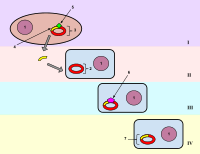
Green synthesis of silver nanoparticles using tomato leaf extract and their entrapment in chitosan nanoparticles to control bacterial wilt.
Sign Up to like & getrecommendations! Published in 2019 at "Journal of the science of food and agriculture"
DOI: 10.1002/jsfa.9656
Abstract: BACKGROUND Silver nanoparticles (AgNPs), particularly those entrapped in polymeric nanosystems, have arisen as options for managing plant bacterial diseases. Among the biopolymers useful for the entrapment of AgNPs, chitosan is promising because of its low… read more here.
Keywords: tomato leaf; silver nanoparticles; leaf extract; bacterial wilt ... See more keywords

The role of soil bacterial community during winter fallow period in the incidence of tobacco bacterial wilt disease
Sign Up to like & getrecommendations! Published in 2018 at "Applied Microbiology and Biotechnology"
DOI: 10.1007/s00253-018-8757-3
Abstract: Bacterial wilt, caused by Ralstonia solanacearum, occurs occasionally during tobacco planting and potentially brings huge economic losses in affected areas. Soil microbes in different management stages play important roles in influencing bacterial wilt incidence. Studies… read more here.
Keywords: incidence; bacterial wilt; period; soil bacterial ... See more keywords

The complete genomic sequence of the novel myovirus RP13 infecting Ralstonia solanacearum, the causative agent of bacterial wilt
Sign Up to like & getrecommendations! Published in 2021 at "Archives of Virology"
DOI: 10.1007/s00705-020-04893-z
Abstract: A novel lytic bacteriophage, Ralstonia phage RP13, was isolated from tomato fields in Pang Nga, Thailand. Electron microscopic observation showed it to have the features of a myovirus with a novel triangulation number (T =… read more here.
Keywords: agent bacterial; rp13; ralstonia; bacterial wilt ... See more keywords

Enhanced biocontrol of tomato bacterial wilt using the combined application of Mitsuaria sp. TWR114 and nonpathogenic Ralstonia sp. TCR112
Sign Up to like & getrecommendations! Published in 2018 at "Journal of General Plant Pathology"
DOI: 10.1007/s10327-018-00834-6
Abstract: We previously identified Mitsuaria sp. TWR114 and nonpathogenic Ralstonia sp. TCR112 as potential biocontrol agents to suppress tomato bacterial wilt caused by Ralstonia pseudosolanacearum. Because commercial biocontrol products require a practical cost-effective application method that… read more here.
Keywords: tcr112; twr114 tcr112; bacterial wilt; tomato bacterial ... See more keywords

Soil fumigation with mustard essential oil to control bacterial wilt in tomato
Sign Up to like & getrecommendations! Published in 2019 at "European Journal of Plant Pathology"
DOI: 10.1007/s10658-019-01777-0
Abstract: In vitro experiments showed that six isolates, belonging to different biovars, were equally susceptible to mustard essential oil (MEO) vapor. The proportion of cell mortality and colony growth inhibition were directly related to the dose… read more here.
Keywords: essential oil; mustard essential; bacterial wilt; fumigation ... See more keywords

Diverse microbial communities in non-aerated compost teas suppress bacterial wilt
Sign Up to like & getrecommendations! Published in 2017 at "World Journal of Microbiology and Biotechnology"
DOI: 10.1007/s11274-017-2212-y
Abstract: Non-aerated compost teas (NCTs) are water extracts of composted organic materials and are used to suppress soil borne and foliar disease in many pathosystems. Greenhouse trials were used to test the effectiveness of NCTs to… read more here.
Keywords: non aerated; aerated compost; bacterial wilt; compost teas ... See more keywords

A practical random mutagenesis system for Ralstonia solanacearum strains causing bacterial wilt of Pogostemon cablin using Tn5 transposon
Sign Up to like & getrecommendations! Published in 2018 at "World Journal of Microbiology and Biotechnology"
DOI: 10.1007/s11274-018-2581-x
Abstract: A practical random mutagenesis system of Ralstonia solanacearum by electroporation with Tn5 transposon was established, which may be utilized to provide genetic approach to study virulence genes of R. solanacearum strains and create nonpathogenic mutants… read more here.
Keywords: practical random; random mutagenesis; cablin; bacterial wilt ... See more keywords

Capture of Ralstonia solanacearum species complex strains directly from plant tissue sampled on FTA cards for molecular characterization
Sign Up to like & getrecommendations! Published in 2019 at "Journal of Plant Pathology"
DOI: 10.1007/s42161-019-00361-z
Abstract: Proper diagnosis of the causal agents and their characterization are critical steps in the management of bacterial wilt of tomato and other solanaceous vegetable crops. As the species and phylotypes of Ralstonia are different in… read more here.
Keywords: characterization; fta cards; solanacearum; bacterial wilt ... See more keywords

Sustainable management of bacterial wilt of tomato using dried powder of Xanthium strumarium L.
Sign Up to like & getrecommendations! Published in 2019 at "Journal of Plant Pathology"
DOI: 10.1007/s42161-019-00451-y
Abstract: Because of its known anti-bacterial properties, we explored the potential of Xanthium strumarium, an invasive, enormous mass-producing weed, for the control of Ralstonia solanacearum which causes bacterial wilt (BW) of tomato. Both in-vitro and in-planta experiments… read more here.
Keywords: succulent shoot; wilt tomato; bacterial wilt; powder ... See more keywords

Distribution, pathological and biochemical characterization of Ralstonia solanacearum in Benin
Sign Up to like & getrecommendations! Published in 2017 at "Annals of Agricultural Sciences"
DOI: 10.1016/j.aoas.2017.05.003
Abstract: Abstract In 2006 and 2007, 75 strains of Ralstonia solanacearum were collected from wilting tomato, pepper and eggplant in Benin. The distribution and the incidence of tomato bacterial wilt in the field were assessed by… read more here.
Keywords: bacterial wilt; benin; solanacearum; benin distribution ... See more keywords

Tobacco bacterial wilt suppression with biochar soil addition associates to improved soil physiochemical properties and increased rhizosphere bacteria abundance
Sign Up to like & getrecommendations! Published in 2017 at "Applied Soil Ecology"
DOI: 10.1016/j.apsoil.2016.12.005
Abstract: Abstract This study evaluated the potential use of biochar made from rice straw to control tobacco bacterial wilt (caused by Ralstonia solanacearum) under field conditions. The results showed that 3 ton ha−1 biochar amendment led to a… read more here.
Keywords: biochar; bacterial wilt; abundance; tobacco bacterial ... See more keywords